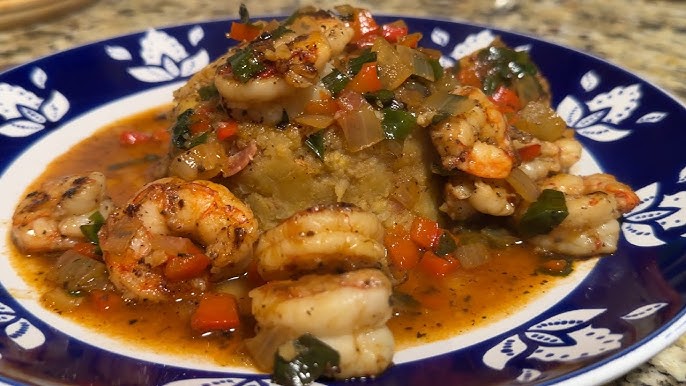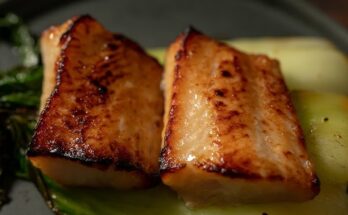Puerto Rican Mofongo Recipe: Mofongo is one of Puerto Rico’s most iconic comfort foods — a flavorful dish made primarily from green plantains that are fried, mashed, and mixed with garlic, olive oil, and crunchy pork cracklings (known locally as chicharrón). Imagine a golden mound of mashed plantains with a rich, garlicky aroma, often served alongside shrimp, chicken, or steak. It’s hearty, comforting, and deeply rooted in Puerto Rican culture.
Unlike mashed potatoes, mofongo has a distinct texture — firm yet soft, with hints of crispiness from the plantains. Every bite delivers a burst of flavor from the garlic and pork fat, creating a perfect blend of savory and starchy satisfaction. It’s not just a dish — it’s a cultural statement, a meal that tells the story of the island’s African, Spanish, and Taíno influences all in one bowl.
The History Behind This Puerto Rican Classic
Mofongo’s origins trace back to African fufu, a dish made from pounded yams or plantains. When enslaved Africans arrived in the Caribbean, they adapted their traditional dish using local ingredients — particularly green plantains. Over time, the recipe evolved, blending African culinary traditions with Spanish seasonings and Taíno techniques.
Puerto Ricans embraced mofongo, making it a national treasure. Today, it’s a staple served in homes, street stalls, and high-end restaurants across the island. Whether you’re celebrating a family gathering or craving a comforting meal, mofongo remains a symbol of Puerto Rican pride and heritage.
Why Mofongo Is So Loved in Puerto Rican Cuisine
Mofongo holds a special place in Puerto Rican hearts for many reasons. First, it’s incredibly versatile — you can stuff it with shrimp in garlic sauce, shredded chicken, steak, or even vegetables. Second, it’s deeply satisfying; the combination of fried plantains and garlic is unbeatable. And finally, it’s a dish that connects generations — passed down from grandparents to grandchildren, always made with love and patience.
In Puerto Rico, mofongo isn’t just food — it’s an experience. From the sound of plantains sizzling in the pan to the aroma of fresh garlic filling the kitchen, making mofongo is as much about the process as the taste.
Ingredients You’ll Need for Authentic Mofongo
Core Ingredients for the Base
To make classic Puerto Rican mofongo, you’ll need the following essential ingredients:
- 3 large green plantains (peeled and cut into 1-inch slices)
- 4 cloves of garlic (freshly minced)
- ½ cup pork cracklings (chicharrón) or fried bacon bits
- ½ cup olive oil or butter
- Salt to taste
- 1 cup vegetable oil (for frying)
Each ingredient plays a vital role in creating the authentic mofongo flavor. The plantains are the base — firm and slightly starchy when green, they fry beautifully and mash to a perfect consistency. Garlic adds a bold punch, while pork cracklings provide crunch and smoky depth. Olive oil or butter brings everything together, ensuring the mash is rich but not dry.
Optional Add-Ons for Extra Flavor
Want to elevate your mofongo to restaurant-level quality? Try these delicious additions:
- Broth (chicken or vegetable) – to moisten the mofongo
- Fresh cilantro or parsley – for garnish
- Cooked shrimp or shredded chicken – for protein
- Sautéed onions and peppers – to add sweetness and texture
- Lemon or lime juice – for a fresh citrusy finish
Adding a few of these optional ingredients lets you customize your mofongo to suit your taste. Whether you prefer it classic and simple or fully loaded, the result will always be mouthwatering.
Tools and Utensils Required
You don’t need fancy equipment to make mofongo — just a few key kitchen tools:
- Mortar and pestle (pilón) – traditional Puerto Rican tool for mashing ingredients
- Frying pan or deep fryer – to fry the plantains
- Tongs – to handle the hot plantains safely
- Mixing bowl – for combining everything together
The pilón is especially important. It’s a wooden mortar and pestle used to mash and mix the plantains, garlic, and chicharrón. Using it gives the mofongo its authentic texture and rustic flavor.
Step-by-Step Guide to Making Mofongo
Step 1 – Prepare the Plantains
Start by peeling 3–4 green plantains — the greener, the better for authentic mofongo texture. Cut them into 1-inch slices and soak briefly in salted water for about 10 minutes. This helps remove excess starch and keeps the plantains from absorbing too much oil while frying.
Step 2 – Fry the Plantains to Perfection
Heat about 2 inches of oil in a skillet over medium heat. Once hot (around 350°F or 175°C), fry the plantain slices in batches for 4–5 minutes per side until golden and tender. They should be cooked through but not too crispy. Remove and drain on paper towels to get rid of excess oil.
Step 3 – Mash the Garlic and Pork Cracklings
In a mortar and pestle (or a sturdy bowl), mash together 3–4 cloves of garlic with a pinch of salt and ½ cup of pork cracklings (chicharrón). The garlic adds aroma, while the crispy pork gives that signature mofongo crunch and depth of flavor.
Step 4 – Combine Ingredients to Create the Mofongo
Add the fried plantains to the garlic-chicharrón mix and mash until everything is well combined. Gradually drizzle in a few tablespoons of warm broth or olive oil as you mash — this helps the mixture come together smoothly without becoming dry. Shape the mofongo into a ball or mound using your hands or a small bowl.
Step 5 – Serve and Garnish Like a Pro
Serve your mofongo hot, topped with sautéed shrimp, roasted chicken, or served alongside a flavorful broth for dipping. Garnish with fresh parsley or a lime wedge for brightness.
Golden, garlicky, and irresistibly savory — mofongo is Puerto Rican comfort food at its finest, a perfect balance of crunch, richness, and heart!
Popular Mofongo Variations You’ll Love
Shrimp Mofongo (Mofongo con Camarones)
If you love seafood, Shrimp Mofongo is an absolute must-try. The savory garlic mash pairs beautifully with juicy shrimp bathed in a buttery, garlicky, and slightly spicy sauce.
To make it, cook shrimp in olive oil with minced garlic, onions, tomatoes, and a touch of paprika or adobo seasoning. Add a splash of white wine or chicken broth to create a flavorful sauce. Spoon the shrimp and sauce over the mofongo mound and garnish with fresh cilantro.
The contrast of creamy, garlicky plantains with tender shrimp is truly divine. This version is popular in Puerto Rican restaurants and coastal towns — it’s comfort food with an elegant twist.
Chicken Mofongo (Mofongo de Pollo)
Chicken mofongo is another favorite variation, especially for those who prefer poultry over seafood. The shredded or grilled chicken adds protein and heartiness, making it a wholesome meal.
You can serve the mofongo topped with sautéed chicken breast, cooked in a garlic and onion sofrito sauce. Or go traditional and pair it with chicken broth poured gently over the mofongo, allowing the mash to soak up all that flavorful liquid.
This version is often enjoyed as a main dish during family dinners — filling, savory, and deeply satisfying.
Vegetarian and Vegan Versions
For a plant-based twist, skip the pork cracklings and replace them with crispy tofu bits or roasted chickpeas. Instead of butter, use olive oil or vegan margarine, and season generously with garlic, herbs, and vegetable broth.
You can also mix in grilled vegetables such as peppers, onions, and mushrooms for added depth. The result? A rich, flavorful mofongo that’s just as satisfying as the traditional version — without any animal products.
This adaptation proves that mofongo’s magic lies not in its meat, but in the love and flavor packed into every bite.
Pro Tips for Perfect Mofongo Every Time
Choosing the Right Plantains
The secret to great mofongo starts with the right plantains. Always use green (unripe) plantains — they’re firmer and starchier, which gives the dish its signature texture.
Yellow or ripe plantains are sweeter and softer, making them unsuitable for traditional mofongo (though they’re great for other dishes like maduros).
When buying plantains, look for ones with vibrant green skin and minimal black spots. If they’re too ripe, refrigerate them to slow down the ripening process.
Balancing the Garlic and Salt
Garlic is the heart of mofongo, but too much can overwhelm the dish. Start with 4 cloves per 3 plantains and adjust to taste. Mash the garlic thoroughly to release its oils and mellow its raw bite.
When seasoning, remember that pork cracklings are already salty, so taste your mixture before adding extra salt. A drizzle of olive oil not only balances the flavors but also gives the mash a beautiful sheen and smooth finish.
How to Keep Mofongo Moist and Flavorful
One common mistake is making mofongo too dry or crumbly. To avoid this, add small amounts of broth or olive oil as you mash. The goal is a consistency similar to mashed potatoes — soft enough to hold together but not mushy.
If reheating, always sprinkle a bit of broth or water before microwaving or pan-heating to restore moisture. And remember: serve it warm, never cold — that’s when mofongo truly shines.
Serving Suggestions and Pairings
Best Side Dishes to Serve with Mofongo
Mofongo is an incredibly versatile dish that pairs beautifully with a variety of sides. Whether you’re serving it as a main course or part of a larger feast, the right accompaniments can elevate the experience.
One of the most traditional pairings is mofongo with a savory broth (caldo) on the side. This broth — made from chicken, beef, or seafood — adds moisture and enhances the garlicky flavor of the mofongo. You can pour it directly over the mound or serve it separately in a small bowl for dipping.
Another classic side dish is arroz con gandules (rice with pigeon peas), a Puerto Rican staple that complements mofongo perfectly. The flavorful rice balances the heaviness of the plantains, creating a satisfying and complete meal.
If you want something fresh, serve mofongo with a side salad of lettuce, tomatoes, avocado, and red onions, lightly drizzled with olive oil and lime juice. The freshness of the vegetables cuts through the richness of the fried plantains, bringing a nice contrast of flavors.
For a full island experience, add fried sweet plantains (maduros) or tostones — these offer a sweet or crispy counterpoint that enhances every bite. And if you want to go all out, top your mofongo with a fried egg or a sprinkle of cheese for that irresistible final touch.
Drinks That Complement Mofongo Perfectly
To complete your Puerto Rican dining experience, pair your mofongo with a refreshing beverage that complements its rich and savory notes.
A cold Medalla Light (Puerto Rico’s famous beer) is a go-to choice — crisp, light, and perfectly balanced against the garlicky, salty goodness of mofongo. If you prefer something non-alcoholic, try freshly squeezed limeade or passion fruit juice (jugo de parcha) — both add a tangy brightness that refreshes the palate.
For a tropical flair, you can’t go wrong with a piña colada, Puerto Rico’s national drink. The sweet coconut and pineapple blend beautifully with the savory mofongo, creating a flavor contrast that feels like a mini vacation in your mouth.
If you’re serving mofongo for dinner, consider pairing it with a light white wine like Sauvignon Blanc or a rum-based cocktail such as a mojito. These options cleanse your palate between bites and keep the meal balanced and enjoyable.
Nutritional Value and Health Benefits
Calories and Macronutrients
While mofongo is indulgent, it can still fit into a balanced diet when prepared mindfully. A standard serving (about one cup) of traditional mofongo contains approximately:
| Nutrient | Amount (per serving) |
|---|---|
| Calories | 350–450 kcal |
| Carbohydrates | 50–55 g |
| Protein | 6–8 g |
| Fat | 15–20 g |
| Fiber | 5–6 g |
Green plantains are a great source of complex carbohydrates and dietary fiber, which aid in digestion and keep you full longer. Garlic provides antioxidants and anti-inflammatory properties, while olive oil contributes heart-healthy fats.
However, since mofongo is fried, moderation is key. To make it lighter, you can fry the plantains in air fryers or bake them instead of deep-frying. This reduces the oil content significantly without sacrificing taste or texture.
How to Make Mofongo Healthier
If you want to enjoy mofongo without the guilt, here are some easy modifications:
- Use olive oil or avocado oil instead of vegetable oil for healthier fats.
- Bake or air-fry plantains for a lighter version.
- Replace pork cracklings with grilled chicken, turkey bacon, or roasted chickpeas.
- Add vegetables like sautéed peppers, onions, and spinach for extra nutrients.
- Serve it with broth instead of sauce to keep it low-calorie but flavorful.
These small adjustments help preserve the authentic flavor while making it more nutritious and heart-friendly — perfect for those who love traditional dishes but want to eat smarter.
Common Mistakes to Avoid When Making Mofongo
Making mofongo might seem simple, but a few common mistakes can affect its texture and flavor. Here’s what to watch out for:
- Using ripe plantains: Ripe (yellow) plantains are sweet and soft, which can make your mofongo mushy. Always choose green, firm ones for that perfect starchy consistency.
- Not frying plantains long enough: Undercooked plantains won’t mash properly. Fry until golden brown but not dark brown — you want them soft inside with a crisp edge.
- Skipping the garlic paste: Garlic isn’t just a flavoring — it’s the heart of mofongo. If you don’t mash it with olive oil and pork cracklings first, the dish will lack depth.
- Over-mashing: Mofongo should be mashed just enough to blend the ingredients but still have some texture. Don’t overdo it, or it’ll turn gummy.
- Serving it dry: A dry mofongo is a tragedy! Add a bit of broth, olive oil, or melted butter to keep it moist.
If you keep these tips in mind, your mofongo will come out flavorful, fluffy, and perfectly balanced every single time.
Storing and Reheating Mofongo the Right Way
Got leftovers? No problem — mofongo stores surprisingly well if handled correctly.
To store:
- Allow it to cool completely before refrigerating.
- Place it in an airtight container to prevent it from drying out.
- It will stay fresh for up to 3 days in the refrigerator.
To reheat:
- Add a splash of broth or water to the mofongo before reheating to restore its moisture.
- Heat it in a covered skillet over low heat or microwave it in 30-second intervals until warm.
- Avoid reheating it multiple times — this can make it rubbery and dry.
If you want to freeze mofongo, portion it into small servings, wrap each tightly in plastic wrap, and store them in a freezer-safe bag. It can last up to 2 months frozen. When ready to enjoy, thaw it in the fridge overnight and reheat as usual.
FAQs about Puerto Rican Mofongo Recipe
1. What type of plantains are best for mofongo?
Always use green (unripe) plantains — they’re starchy and firm, which gives mofongo its ideal texture. Ripe plantains are too sweet and soft.
2. Can I bake plantains instead of frying them?
Yes! Baking or air-frying is a healthier alternative. Brush the plantains with olive oil and bake at 400°F (200°C) for about 20 minutes until golden.
3. How can I make mofongo without pork?
Simply replace pork cracklings with crispy tofu, roasted chickpeas, or turkey bacon for a lighter or vegetarian version.
4. Is mofongo gluten-free?
Absolutely! Mofongo is naturally gluten-free since it’s made from plantains, garlic, and seasonings — just ensure your add-ons are gluten-free too.
5. What’s the best sauce to serve with mofongo?
A garlic butter sauce or Puerto Rican creole sauce (salsa criolla) complements mofongo beautifully. For seafood mofongo, a shrimp broth or lemon garlic butter sauce is perfect.
Conclusion
Mofongo isn’t just a meal — it’s a piece of Puerto Rico’s soul. From its humble African roots to its evolution into a national treasure, this dish embodies the island’s rich history and love for bold, comforting flavors. Whether you enjoy it stuffed with shrimp, chicken, or veggies, mofongo delivers that perfect blend of crunch, creaminess, and garlicky goodness in every bite.
It’s a dish that brings people together — whether around a family table or at a lively street-side eatery in Old San Juan. So next time you’re craving something hearty, flavorful, and authentically Puerto Rican, grab some green plantains and whip up a batch of mofongo. Your taste buds will thank you!



